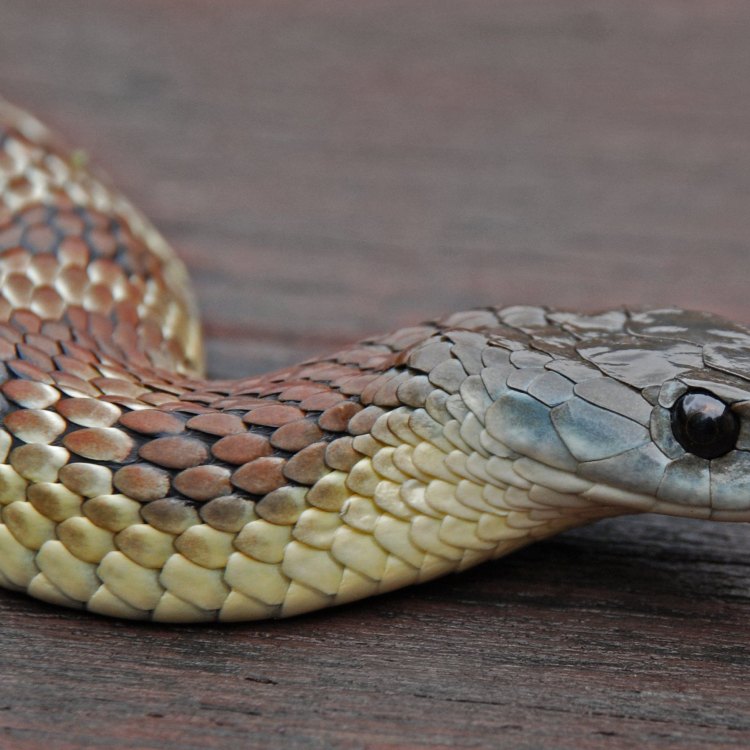
Tiger Snake
Up to 1.8 meters (6 feet)
The Tiger Snake, found in Southeastern and Southwestern Australia, is a slender and elongated Elapidae family member. Growing up to 1.8 meters in length, this venomous snake is a common sight in the region. Its name comes from the distinctive, tiger-like stripes on its body. Be careful if you encounter one in the wild, as their venom can be highly potent.
Animal Details Summary:
Common Name: Tiger Snake
Kingdom: Animalia
Habitat: Wetlands, grasslands, forests, and coastal dunes
The Mighty Tiger Snake: An Iconic Reptile of Australia
Australia, the land down under, is home to a diverse range of animals, from cuddly koalas to fierce crocodiles. But there is one creature that stands out among the rest – the tiger snake. With its striking appearance and deadly reputation, it has captured the fascination of people all over the world. In this article, we will dive deep into the world of the tiger snake, exploring its anatomy, behavior, and significance in Australian ecosystems Tiger Snake.An Introduction to the Tiger Snake
The scientific name of the tiger snake is Notechis scutatus, derived from the Greek words "notos" meaning south and "echis" meaning viper. This venomous reptile is commonly known as the tiger snake due to its distinctive black and yellow coloration, resembling that of a tiger. It is a member of the Elapidae family, which includes other venomous snakes such as cobras and coral snakes.Tiger snakes are native to Australia, specifically found in the southern and southwestern regions, including the islands of Tasmania and Kangaroo Island. They prefer a diverse range of habitats, including wetlands, grasslands, forests, and coastal dunes. This adaptable nature has allowed them to thrive in different environments, making them a common sight in many parts of the country.
Physical Characteristics
The tiger snake is a medium-sized snake, growing up to 1.8 meters (6 feet) in length. However, some specimens have been recorded to reach lengths of up to 2 Thalassomedon.1 meters (7 feet). They have a slender and elongated body, with a distinct flattened head and a narrow neck. This body shape allows them to move swiftly and effortlessly, making them efficient hunters.One of the most striking features of a tiger snake is its coloration. While the base color of the snake is usually dark brown or black, they have lighter bands or stripes running down their body. The coloration varies among individuals and can also change depending on their habitat. This serves as camouflage, making them difficult to spot in their natural environment.
Diet and Feeding Habits
Tiger snakes are carnivorous, meaning they primarily feed on other animals. They are opportunistic hunters, preying on a variety of animals such as small mammals, birds, frogs, and even other snakes. Their diet is not limited to a particular food source, making them versatile predators.To hunt their prey, tiger snakes rely on their highly developed sense of smell and heat-sensing pits on their head. Once they have located their prey, they strike quickly, injecting a potent venom that paralyzes their victim. This highly efficient method of hunting allows them to take down prey larger than themselves, including mice and small birds.
Dangerous Venom and Its Effects
As a member of the Elapidae family, the tiger snake possesses a potent neurotoxic venom, meaning it affects the nervous system of its victim. One bite from this snake can deliver enough venom to kill a human within a few hours. However, due to the development of antivenom and prompt medical treatment, fatalities from tiger snake bites are rare.The venom of a tiger snake can cause a range of symptoms, including headache, nausea, vomiting, paralysis, and respiratory failure. If left untreated, it can lead to death. Therefore, it is crucial to seek medical attention immediately after a tiger snake bite.
The Importance of Tiger Snakes in the Ecosystem
Despite their deadly reputation, tiger snakes play a crucial role in maintaining the balance of ecosystems in Australia. As predators, they help control the population of small mammals and other animals, preventing them from overgrazing on vegetation. They also provide a food source for birds of prey and other predators, contributing to the overall health of the ecosystem.In addition, the venom of tiger snakes has proven to be valuable in medical research, particularly in the development of antivenom. Their venom contains unique enzymes and proteins that can help treat conditions such as stroke, heart attacks, and blood clots. Therefore, these snakes not only serve an essential role in the natural world but also have the potential to save human lives.
Thriving in a Threatening World
While tiger snakes play a vital role in ecosystems, they face numerous threats from human activities. Habitat destruction, particularly through land development and draining of wetlands, has greatly affected their populations. In addition, illegal collection for the pet trade and deliberate killings by humans have also contributed to their decline.Fortunately, tiger snakes are listed as a protected species in Australia, making it illegal to harm or capture them without a license. Conservation efforts, such as habitat restoration and educational programs, have also been implemented to ensure the survival of these snakes in the wild.
Conclusion
In conclusion, the tiger snake is a fascinating and iconic reptile of Australia. From its striking appearance and deadly venom to its important role in the ecosystem, this snake continues to captivate the minds of people all over the world. As with any other animals, it is essential to respect and protect these creatures to ensure their survival in the ever-changing world we live in. So, if you ever come across a tiger snake in the wild, remember to admire it from a safe distance and let it continue its crucial role in nature.

Tiger Snake
Animal Details Tiger Snake - Scientific Name: Notechis scutatus
- Category: Animals T
- Scientific Name: Notechis scutatus
- Common Name: Tiger Snake
- Kingdom: Animalia
- Phylum: Chordata
- Class: Reptilia
- Order: Squamata
- Family: Elapidae
- Habitat: Wetlands, grasslands, forests, and coastal dunes
- Feeding Method: Carnivorous
- Geographical Distribution: Australia
- Country of Origin: Australia
- Location: Southeastern and Southwestern Australia
- Animal Coloration: Variable but typically dark brown or black with lighter bands
- Body Shape: Slender and elongated
- Length: Up to 1.8 meters (6 feet)

Tiger Snake
- Adult Size: 1-1.5 meters (3-5 feet)
- Average Lifespan: 10-15 years
- Reproduction: Oviparous (lays eggs)
- Reproductive Behavior: Mating occurs in spring and females lay 12-40 eggs
- Sound or Call: Hisses when threatened
- Migration Pattern: Seasonal movements within their habitat
- Social Groups: Solitary
- Behavior: Aggressive when threatened
- Threats: Habitat loss, pollution, and persecution
- Conservation Status: Least Concern
- Impact on Ecosystem: Top predator, plays a crucial role in maintaining ecosystem balance
- Human Use: None
- Distinctive Features: Distinctive patterning with dark bands across the body and head
- Interesting Facts: Tiger snakes are highly venomous and responsible for the majority of snakebite deaths in Australia
- Predator: Birds of prey, larger snakes, and some mammals

Notechis scutatus
The Enigmatic Tiger Snake: A Top Predator That Commands Fear and Respect
Australia is a land known for its diverse and unique wildlife, and the tiger snake is one such species that commands fear and respect. With its distinctive patterning and deadly venom, this snake is a top predator in its ecosystem and plays a crucial role in maintaining balance. In this article, we will explore the fascinating world of the enigmatic tiger snake and uncover its unique features, behavior, and role in the ecosystem.Adult tiger snakes can grow to an average length of 1-1 PeaceOfAnimals.Com.5 meters (3-5 feet), making them one of the larger species of snakes in Australia. They can be found in various habitats, including wetlands, grasslands, and coastal regions, across southern and eastern Australia.
With an average lifespan of 10-15 years in the wild, these snakes have plenty of time to establish their dominance in their habitat. But what truly sets these snakes apart is their reproductive behavior, which is quite different from other snake species.
Unlike most snakes, tiger snakes are oviparous, which means they lay eggs rather than giving birth to live young. Mating typically occurs in the spring, and female tiger snakes can lay anywhere between 12-40 eggs at a time. The female snake then coils around her eggs, providing warmth and protection until they hatch.
It is during this time that these otherwise solitary snakes can be found in small social groups, showcasing their nurturing side. But don't be fooled by their maternal behavior; tiger snakes are known to be fiercely aggressive when threatened Tussock Moth Caterpillar.
When threatened, these snakes are quick to hiss, a sound that has earned them the nickname of "the hissing death." This warning is often enough to deter potential attackers, but if threatened further, the tiger snake can strike with lightning speed, injecting its powerful venom into its victim.
Their venom is highly potent and can cause paralysis, respiratory failure, and even death in humans. In fact, they are responsible for the majority of snakebite deaths in Australia, making them one of the most feared and respected species in the country.
But despite their reputation, tiger snakes are not out to harm humans. They only attack when threatened or provoked and would rather avoid confrontation. However, their aggressive behavior has made them a target for persecution, and they face several threats in the wild.
Habitat loss due to human development, pollution, and persecution by humans are the main threats to tiger snakes. These snakes are also often killed by humans out of fear or for sport, causing their populations to decline in many areas.
This has led to conservation efforts to protect the species, and luckily, the tiger snake is currently classified as "Least Concern" on the IUCN Red List. However, continued conservation efforts are necessary to ensure their survival and maintain their vital role in the ecosystem.
As top predators, tiger snakes play a crucial role in maintaining the balance of their habitat. They feed on a wide variety of prey, including rodents, frogs, lizards, and even other snakes. By controlling the population of these animals, tiger snakes help prevent overgrazing and maintain the health of their ecosystem.
But their impact doesn't end there. Tiger snakes are an important food source for birds of prey, larger snakes, and some mammals, further highlighting their role in the food chain. This makes their conservation even more critical, as the loss of tiger snakes could have a ripple effect on the entire ecosystem.
Another fascinating feature of the tiger snake is its distinctive patterning. As the name suggests, these snakes have a distinctive pattern resembling the stripes of a tiger. Their body and head are covered in dark bands, creating an eye-catching appearance.
However, this pattern is not just for show; it serves as camouflage in their natural habitat, allowing them to blend in with their surroundings. This helps them avoid detection by predators and also allows them to surprise their prey.
These unique features and behaviors make the tiger snake an intriguing and enigmatic species, worthy of our admiration and respect. But despite their intriguing nature, there is still much to learn about these elusive creatures.
Due to their solitary and elusive nature, studying tiger snakes in the wild is a challenging task. However, advancements in technology and research have allowed us to gain a better understanding of these snakes and their importance in their ecosystem.
But unfortunately, many misconceptions and fears still surround this misunderstood species. As we continue to learn more about tiger snakes, it is vital to educate the public about their true nature and importance in the ecosystem. This will not only help dispel fears but also foster a greater appreciation for these magnificent creatures.
In conclusion, the tiger snake is a unique and vital species in the Australian ecosystem. With its distinctive patterning, aggressive behavior when threatened, and important role as a top predator, this snake commands both fear and respect.
But despite their deadly venom and fearsome reputation, these snakes are crucial for maintaining ecosystem balance and deserve our protection and admiration. Let us continue to learn and appreciate the enigmatic tiger snake and work towards its conservation for generations to come.

The Mighty Tiger Snake: An Iconic Reptile of Australia
Disclaimer: The content provided is for informational purposes only. We cannot guarantee the accuracy of the information on this page 100%. All information provided here may change without prior notice.












